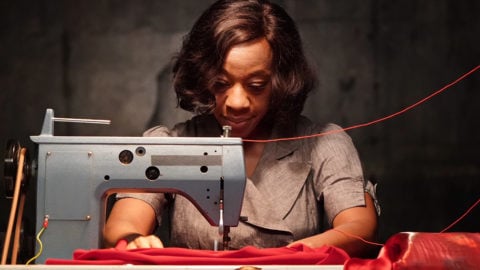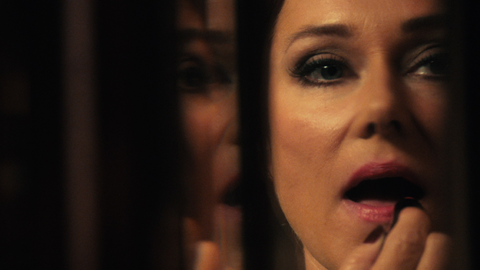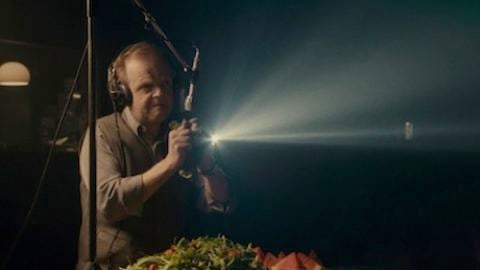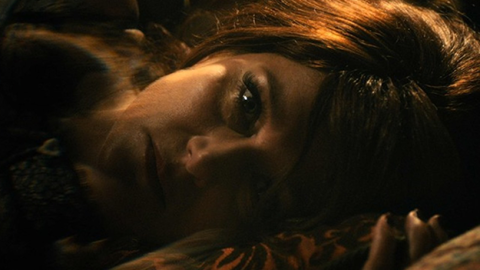Film of the Week: In Fabric
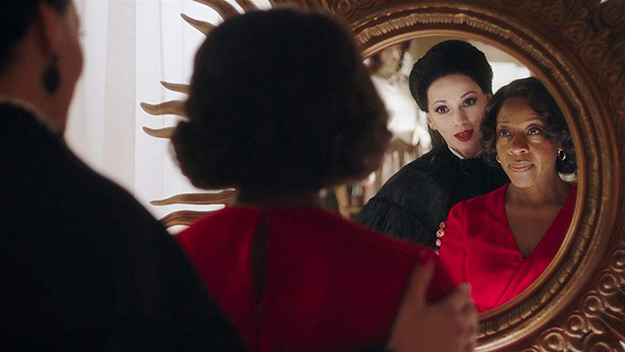
All images from In Fabric (Peter Strickland, 2019)
Play a game of word association, and the first thing someone is likely to blurt out in response to “English” is “eccentric.” Yet eccentricity is strikingly thin on the ground in British cinema these days, and has been for a long time: experiment, waywardness and what’s often disparagingly termed “artiness” are generally anathema to a cinematic mindset that favors realism and social responsibility above all things. The last hardcore English eccentric in British film—and by “eccentric,” I mean taking pleasure in imagery, imagination, play, a radical aversion to the rule of the real—was Peter Greenaway, whose contribution to UK screen culture has largely been written out of history (partly because his output, from the ’90s on, was so disappointingly overblown).
Some British filmmakers still follow non-conformist paths in different ways —among them, Carol Morley, Joanna Hogg, Andrew Kötting, and Ben Rivers, although the latter two are essentially artists working with quasi-documentary methods to process the real world through their singular imaginations. But Greenaway in his ’80s prime was the last British film-maker to completely create vivid self-enclosed fictional worlds that were entirely the product of the imagination.
Right now, there’s only one comparable “English Eccentric,’” pulling wild efflorescences out of his head—although as a cinephile, he’s also pulling them partly out of cinema. That is Peter Strickland, whose singularity as a British filmmaker comes partly out of his status as an exile. Long resident in Hungary, he shot his breakthrough feature, 2009’s Katalin Varga in Romania; it’s closest of all his films to realist drama, but it’s also a piece of cinematic forgery, his personal re-imagining of a Balkan film from some distant decade.
All Strickland’s subsequent work has hung on a similar cultural displacement. Berberian Sound Studio (2012), his tribute to the extremities of Italian horror, was about a hidebound English sound designer out of his depth in Rome, trying to put a soundtrack to a giallo movie. The Duke of Burgundy (2014) was a decorous but profoundly strange sapphic fantasia that channeled ’70s Euro erotica, somewhere between Jess Franco and Alain Robbe-Grillet.
His latest film In Fabric, by contrast, is a profoundly English work, steeped in a knowing mundanity that nicely plays up the weirdness; in fact, this film is so thoroughly English that it feels more like a foreign director’s fantasy about the strangeness of Britain. It’s English in the same way that Antonioni’s Blow-Up was, or Jerzy Skolimowski’s Deep End.
In Fabric is an essay in comic horror, pairing two stories about an apparently cursed or haunted red dress bought in a department store in the fictional suburban or small town location of “Thames-Valley-on-Thames.” The first story is about harassed middle-aged Sheila (Marianne Jean-Baptiste), recently separated from her husband and looking for a new love, while she faces routine trouble at the bank where she works, and stressful relationships with her son Vince. Nothing in the setting quite chimes, nor is it meant to. The decor and the social habits—such as lonely-hearts dating in pre-internet style—suggest a stylized version of Britain’s shoddy but would-be rakish ’70s, although Vince wears dreads in a very post-’70s style. Played by Jaygann Ayeh, he also seems way too old to be an adolescent still studying for his A-levels at school, but then that makes it seem all the more louche that he has a torrid relationship with his presumably older, and extremely louche girlfriend, Gwen (Gwendoline Christie), who models for his erotico-mystical artwork and hangs around the house, addressing Sheila with regal disdain.
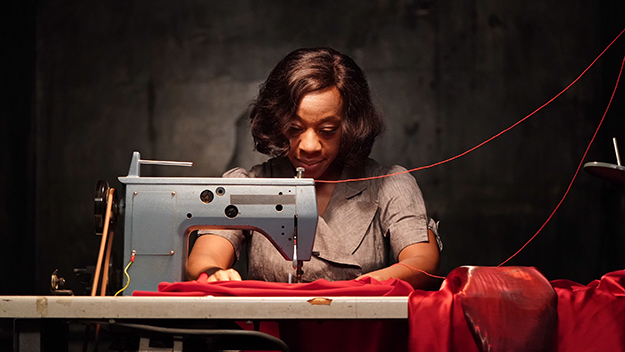
At work, Sheila has to face excruciatingly polite interviews with her bosses (a gently Pythonesque double act from Steve Oram and Julian Barrett), a gay couple who favor corporate role-play with historical costumes optional. Little wonder that she seeks romance, and eventually seems to find it with smooth, sympathetic Zach (composer and sometimes avant-pop musician Barry Adamson, convincingly making his big screen acting debut).
Sheila hopes to transform her luck, and her appeal, with the aid of a new dress—and finds a dazzling number in brilliant red from the local department store Dentley and Soper’s. Such places have a singular hold on the British cultural imagination, partly as the result of the ’70s sitcom Are You Being Served?, which imagined them as palaces of fussily pretentious fussy seediness and soul-crushing stereotype. Strickland has a lot of fun imagining the store, a functionally faux-glamorous consumer palace of the old school, which announces its sales season in decidedly sinister TV adverts—a soundtrack of wheedling synthesizer arpeggios, and distorted images of the sales force beckoning the viewer like Dracula’s brides inviting Jonathan Harker in for a cosy chat about real estate.
The shop’s assistants are a cadre of women in black Victorian dresses and lacquered black hair, who seem as much animated showroom dummies as women—while the shop’s dummies are themselves weirdly alive in a disturbingly sexual way. The film’s prize performance, not least because it’s by far the oddest, is Fatma Ahmed as the seductively smiling assistant Miss Luckmoore, who plies Sheila in a silky, hard-to-identify foreign accent with poetic sales talk that sounds as if translated from a Balkan philosophy manual. Strickland’s script tartly plays the exoticism against down-to-earth Britishness. When Miss Luckmoore oozes, “Our fabric is recollection of touch,” Sheila looks askance at the dress and replies, “Isn’t it a bit small?”
The dress’s supposed uncanny powers are perhaps the least interesting thing about the film. The model (briefly-glimpsed Sidse Babett Kudsen) who modeled it for the shop’s catalogue—where its color is ominously described as “Artery Red’’—died soon after in grisly circumstances—but that feels like a derisory generic touch. The dress may do mysterious things, like move around of its own accord, or hover balefully in mid-air over sleepers’ heads. But here Strickland seems to be merely winking at a “haunted fabric’” tradition of supernatural stories that was big in the 19th century (Balzac’s The Wild Ass’s Skin, Gogol’s The Overcoat) and still can do good service today, as you’d hope any robust second-hand schmutter will do. What Strickland is really interested in is the suggestive visual and rhythmic possibilities that the garment provides: like lusciously fetishized images in extreme close-up of scarlet-nailed fingers caressing the dress’s silky surface, or the dress, blown by wind on a clothesline, shuddering in textile ecstasy, less fabric than flame. Strickland’s retro fetishism is painstaking and joyous too, from the details of the store’s catalogue, that catch a distinctive tone of suburban cod-glamour, to the hectic montages of period black-and-white stills.
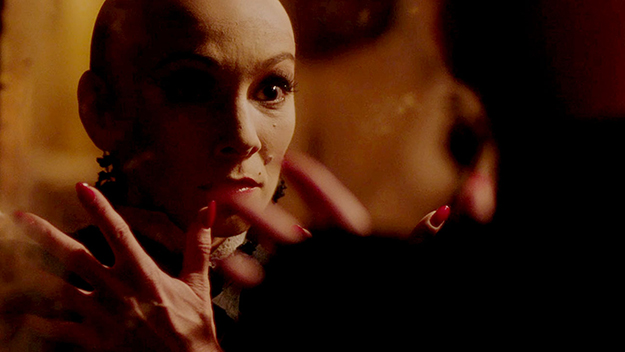
As I said, In Fabric is a diptych, and it comes as a jolt when Sheila’s story comes to an abrupt end. The second tale offers a rather coarser take on English social and sexual manners; it’s about lugubrious, childlike Reg (Leo Bill), who repairs washing machines and who is due to marry long-term fiancée Babs (Hayley Squires). This time the red dress turns up on Reg: it’s bought for his humiliation by his mates and his monstrously aggressive father-in-law on a lads’ night out. For all his sorrows, Reg has one bizarre talent: when he launches into monotone, pedantic discussions of washing machine malfunctions, the listener immediately goes into an helpless erotic trance. This happens in a lovely scene with a wearily flirtatious customer (Caroline Catz), transfixed by his talk “agitator hubs” and “wig-wag solenoids” (there’s surely a nod here to the ultra-drab comedy soft-porn that was a staple of British ’70s cinema: Confessions of a Window Cleaner, et al).
The second half is markedly less interesting than the first, with a tone of satire that offer a harsh sitcom take on the familiar territory of UK social realism (Jean-Baptiste made her name in Mike Leigh’s Secrets and Lies, Leo Bill is a Leigh regular, and Squires starred in Ken Loach’s I, Daniel Blake). There’s an arguably ugly note in the sheer horror of Babs’s dad and his gang, a cartoon image of British working-class malehood that looks a bit sneery here—or perhaps explains why Strickland hightailed it from the UK years ago. But the second story slightly dilutes the film’s distinctiveness. Still, Strickland wraps things up on a suitably nightmarish note, with a genteel spat at the shop counter tipping over into apocalypse, and a memorable “dead souls” image by way of conclusion.
One of the film’s pleasures is seeing Marianne Jean-Baptiste in a substantial lead role again; she’s terrific as a flustered middle-aged woman trying to reconnect with her romantic self, while struggling with humiliations at work and at home (her reactions to Gwen’s snidely aristocratic one-liners make for priceless battle duets). It’s hard to know exactly how her casting inflects the film in terms of racial subtext: Sheila, her son and her suitors are black in a world that is steeped in a particular English suburban cultural whiteness, and when a character at one point mutters the word “Racist,” it feels like merely a sardonic throwaway. Of course, the dress itself represents a kind of skin, or a disguise—embodying a fake dream of bourgeois European culture (Mediterranean cruises and “canapé conversations,” Dentley and Soper’s catalogue puts it). But it’s hard to see quite how consistently this theme articulates itself; it feels as if it’s central if you want to read it as such, merely incidental if you don’t.
This is a film that seems either incomplete or unafraid of wandering down a blind alley, but that seems to be a peculiarity of Strickland’s cinema: Berberian Sound Studio had a similarly implosive, self-consuming ending. It’s perhaps in the nature of this kind of Buñuelian imagination that it produces images that are mysterious in the sense that they’re ultimately conducive to no interpretation except as images. In this film, however, he’s not offering only images, but textures of a remarkable richness and density: the lush, lurid shades of Ari Wegner’s cinematography; Paki Smith’s production design, which merges the eerily baroque and the shamelessly tacky and archaic; Matyas Fekete’s rhythmically disjointed editing; and the pastiche period synth and crypto-muzak of the score by Stereolab spin-off band Cavern of Anti-Matter. At its best, In Fabric achieves a density that transcends weirdness to become authentically alien—nightmare stitched into its very tissue.
Jonathan Romney is a contributing editor to Film Comment and writes the Film of the Week column. He is a member of the London Film Critics Circle.



